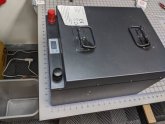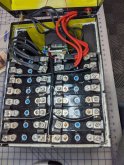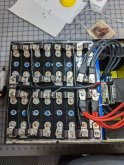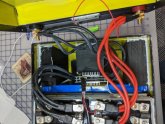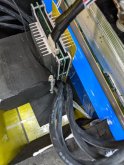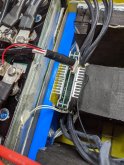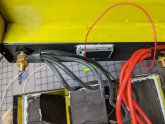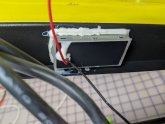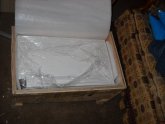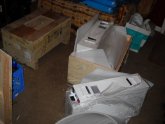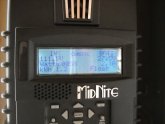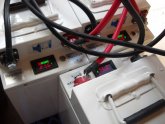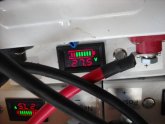krby
Solar Enthusiast
Note: I am not affiliated with the company, and have not been compensated in any way for this review, I'm just a customer and I don't see much info about these batteries on this forum, so I thought I would share my experience.
In a few different posts people have asked about the LFE packs available from PacificSun Systems or SpecializedPower.net. I bought a 24V 200Ah LFE pack from them. It arrived a few days ago and I just got done doing a couple of charge/discharge cycles.
TL;DR / Summary
The battery took longer than I expected to arrive, but that was a misunderstanding on my part. So far in two charge/discharge cycles, I've gotten a little over 4.4kWh of usable AC power from my inverter, so the pack appears to be as advertised. I'm a happy customer! Also, I haven't taken the battery apart, so now teardown report here.
Ordering thru Delivery (Nov 11th - Dec 26th)
I started off looking at the Pacific Sun Systems website, as soon as I started looking at the batteries, I was redirected to Specialized Power Systems. Both websites say that Specialized Power is battery division of Pacific Sun. I looked around a bit over about a week, and finally decided to order. When I placed the order, I had trouble getting the website to accept a credit card. I ended up selecting "Cashier's Check" as the payment option, submitting the order, then emailing the company. Within a few hours, they had me sorted out. As promised, the next morning I got an invoice to pay via PayPal (I used a credit card via PayPal). Given the lack of reviews or experience with this company, I was nervous about the whole thing, but hopeful.
It appears each battery is made to order (in China, I assume) so you can customize a few things like M10 terminals or Anderson SB connectors, BMS current limits, etc. When I ordered, I didn't realize each battery was built on order, or may have asked what other options there were for shapes and and cases. If anyone is considering ordering, I encourage you to reach out to them via email, they were very very helpful.
Because this is made to order, the lead time was longer than I expected. I missed the part of the website where they say 15-20 business days before shipping. This was my mistake, and I probably frustrated the sales/support guy Zack by being so impatient. In my case, payment was made on Nov 12th and I got a FedEx tracking number on Dec 17th. Shipping was by a freight forwarder then to FedEx. Looking at the tracking history, FedEx got it on Dec 23rd and I had it at my door on Dec 26th. I'm giving all this detail so that if other people order, they don't worry like I did and know that this delay is a normal experience.
Battery / Setup
The battery arrived in a pretty abused FedEx cardboard box. FedEx left it on my porch upside down (there were clearly "up this way!" arrows all over the box). Inside the cardboard box was a wood crate with a hinged lid and latch. Inside the wood crate, the battery was really well padded with foam. The battery on its own weighs about 90lbs and is in a metal case with M10 terminals on it. It has an LCD Volt Meter mounted in the case. I'm 99% it is this one from DROK, I have asked them to confirm (have I mentioned how helpful they are via email?) Also included was a Chinese/English manual and a pair of 2/0 cables (maybe 2-3ft) with crimped M10 lugs. This was good, because I had planned on M8 lugs and had only 5/16th gear ready!

The manual looks like it's maybe from whoever manufactured the cells. It suggests:
For my build, I'm using a Victron MultiPlus 24/3000 Inverter/Charger. I don't have the final case it all goes in, so I hacked up a 14AWG extension cord for AC in and out to the MultiPlus. Don't do this for anything but bench testing. The battery has a terminal mount 200A mount fuse on it, but with this temp extension cord, I've left out the fuses on AC in and AC out. Those will go in my actual build.

I really wanted to do a larger load and more controlled test. My original plan was to use this to use my EV charger as a load, but the night before I realized that I this Victron unit outputs 120V, my EV charger is 240V, and even if I could make it operate on 120V it would only use about 12A. In the US, they're usually designed for 80% of a typical 15A outlet. So, to get the tests running quickly was limited to 120V household appliances. The Victron MultiPlus has two separate AC Out terminals. I could have wired up another line, but I only had one extension cord that was in the junk bin. In the end, I used a space heater, that is rated for 1500W. It's cold in the garage, so it wasn't completely wasted energy!
Test1
After an aborted charge (see my notes above about the BMS maybe cutting out). I measured the batt at 26.65V with a trusted DMM. The LCD said 26.6V, the Victron said 26.64V. I plugged a Kill-A-Watt and my space heater...

Other folks on this forum have noted that a Kill-A-Watt may melt with extended loads of high current. To help with this, I ran a fan (from house AC, not the inverter) across the Kill-A-Watt so that it blew on both the front and back plugs. For my 3hr tests, this worked fine.
During the test, my AC load was about 1450W. To lower current a bit, I eventually changed the output AC on the Victron to 124V. My research suggests up to 126.5VAC should be ok. The Victron app had these numbers during one snapshot I grabbed: DC In - 25.87V 61.30A. AC Out - 1441W (I didn't record the volts and amps).
At just under 3hrs, the low battery light tripped on the Victron. I stopped the test manually at 3h1m:
Test2
The next morning, the battery had dropped down to 27.2V, I believe this is considered nearly full? The one wiring change I made was to add a 16AWG v-sense wire from the Victron to the battery. My goal was to make sure the Victron had a more accurate reading of the battery voltage, but in practice I'm not sure how much the helped. 40-50A of current at 25-26VDC over 5-6ft of 2/0 cable doesn't have much drop. I turned on the charger a bit, and it was immediately in absorb phase.
09:34a - Start. Battery was at 27.5V under no load
09:34a - Victron software showed DC In: 26.31V 61A. AC Out: 124V 11.91A, 1460W
11:35a - Victron low battery light turned on. I had this set to 25.5V, I changed it to 25V
11:36a - Victron software shows DC In at about 25.53V 63A (changing rapidly)
12:40p - I came back to find the heater turned off! Low voltage cut-off may have tripped?
12:41p - Kill-A-Watt said 4.42kWh used.
12:50p - Battery at rest shows 24.7V. Restarted the load.
12:53p - Under load Victron software shows 24V 67A and voltage dropping quickly, so I stopped the test.
12:54p - No load, battery voltage recovers back to 24.00V
01:05p - Battery at 24.21V
01:24p - Battery at 24.30V (DMM shows 24.28V)
Final Kill-A-Watt total is 4.47kWh.
A few times I calculated between 87-90% efficiency in the inverter (DC In vs AC out), this also includes the power to run the Victron itself. So I think 4.47kWh of AC out is about 5kWh of DC from the battery, which is more than I should be pulling from it, but I think this tells me that I did get the battery I expected!
Looking forward to your comments and questions.
In a few different posts people have asked about the LFE packs available from PacificSun Systems or SpecializedPower.net. I bought a 24V 200Ah LFE pack from them. It arrived a few days ago and I just got done doing a couple of charge/discharge cycles.
TL;DR / Summary
The battery took longer than I expected to arrive, but that was a misunderstanding on my part. So far in two charge/discharge cycles, I've gotten a little over 4.4kWh of usable AC power from my inverter, so the pack appears to be as advertised. I'm a happy customer! Also, I haven't taken the battery apart, so now teardown report here.
Ordering thru Delivery (Nov 11th - Dec 26th)
I started off looking at the Pacific Sun Systems website, as soon as I started looking at the batteries, I was redirected to Specialized Power Systems. Both websites say that Specialized Power is battery division of Pacific Sun. I looked around a bit over about a week, and finally decided to order. When I placed the order, I had trouble getting the website to accept a credit card. I ended up selecting "Cashier's Check" as the payment option, submitting the order, then emailing the company. Within a few hours, they had me sorted out. As promised, the next morning I got an invoice to pay via PayPal (I used a credit card via PayPal). Given the lack of reviews or experience with this company, I was nervous about the whole thing, but hopeful.
It appears each battery is made to order (in China, I assume) so you can customize a few things like M10 terminals or Anderson SB connectors, BMS current limits, etc. When I ordered, I didn't realize each battery was built on order, or may have asked what other options there were for shapes and and cases. If anyone is considering ordering, I encourage you to reach out to them via email, they were very very helpful.
Because this is made to order, the lead time was longer than I expected. I missed the part of the website where they say 15-20 business days before shipping. This was my mistake, and I probably frustrated the sales/support guy Zack by being so impatient. In my case, payment was made on Nov 12th and I got a FedEx tracking number on Dec 17th. Shipping was by a freight forwarder then to FedEx. Looking at the tracking history, FedEx got it on Dec 23rd and I had it at my door on Dec 26th. I'm giving all this detail so that if other people order, they don't worry like I did and know that this delay is a normal experience.
Battery / Setup
The battery arrived in a pretty abused FedEx cardboard box. FedEx left it on my porch upside down (there were clearly "up this way!" arrows all over the box). Inside the cardboard box was a wood crate with a hinged lid and latch. Inside the wood crate, the battery was really well padded with foam. The battery on its own weighs about 90lbs and is in a metal case with M10 terminals on it. It has an LCD Volt Meter mounted in the case. I'm 99% it is this one from DROK, I have asked them to confirm (have I mentioned how helpful they are via email?) Also included was a Chinese/English manual and a pair of 2/0 cables (maybe 2-3ft) with crimped M10 lugs. This was good, because I had planned on M8 lugs and had only 5/16th gear ready!

The manual looks like it's maybe from whoever manufactured the cells. It suggests:
- Bulk / Absorb voltage: 3.65V x cells (3.65V x 8 = 29.2V). This feels high, and I had trouble charging at this setting, so for the tests I used 3.5 x 8 = 28V)
- Absorb cut-off voltage: 0.01C (200Ah x 0.01 = 2A) <-- My Victron MultiPlus won't do current-based ending of the Absorb stage, so just made the Absorb time as short as possible, 1hr.
- Suggested charge current: 0.2C (200Ah x 0.2 = 40A). I’m charging at 50A (0.25C), and asked them to set the BMS to allow at least 50A charge current when I ordered.
- Discharge cut-off: 2.5V x cells = (2.5 x 8 = 20V) This seems too low, so I set my Victron at using 2.875V x 8S = 23.0V
For my build, I'm using a Victron MultiPlus 24/3000 Inverter/Charger. I don't have the final case it all goes in, so I hacked up a 14AWG extension cord for AC in and out to the MultiPlus. Don't do this for anything but bench testing. The battery has a terminal mount 200A mount fuse on it, but with this temp extension cord, I've left out the fuses on AC in and AC out. Those will go in my actual build.

I really wanted to do a larger load and more controlled test. My original plan was to use this to use my EV charger as a load, but the night before I realized that I this Victron unit outputs 120V, my EV charger is 240V, and even if I could make it operate on 120V it would only use about 12A. In the US, they're usually designed for 80% of a typical 15A outlet. So, to get the tests running quickly was limited to 120V household appliances. The Victron MultiPlus has two separate AC Out terminals. I could have wired up another line, but I only had one extension cord that was in the junk bin. In the end, I used a space heater, that is rated for 1500W. It's cold in the garage, so it wasn't completely wasted energy!
Test1
After an aborted charge (see my notes above about the BMS maybe cutting out). I measured the batt at 26.65V with a trusted DMM. The LCD said 26.6V, the Victron said 26.64V. I plugged a Kill-A-Watt and my space heater...

Other folks on this forum have noted that a Kill-A-Watt may melt with extended loads of high current. To help with this, I ran a fan (from house AC, not the inverter) across the Kill-A-Watt so that it blew on both the front and back plugs. For my 3hr tests, this worked fine.
During the test, my AC load was about 1450W. To lower current a bit, I eventually changed the output AC on the Victron to 124V. My research suggests up to 126.5VAC should be ok. The Victron app had these numbers during one snapshot I grabbed: DC In - 25.87V 61.30A. AC Out - 1441W (I didn't record the volts and amps).
At just under 3hrs, the low battery light tripped on the Victron. I stopped the test manually at 3h1m:
- Kill-A-Watt had 4.34kWh of AC used.
- Battery LCD shows 24.3V under almost no load (25W) right after I stopped. 10m after stop: 24.8V, 28min after stop: 25.0V
Test2
The next morning, the battery had dropped down to 27.2V, I believe this is considered nearly full? The one wiring change I made was to add a 16AWG v-sense wire from the Victron to the battery. My goal was to make sure the Victron had a more accurate reading of the battery voltage, but in practice I'm not sure how much the helped. 40-50A of current at 25-26VDC over 5-6ft of 2/0 cable doesn't have much drop. I turned on the charger a bit, and it was immediately in absorb phase.
09:34a - Start. Battery was at 27.5V under no load
09:34a - Victron software showed DC In: 26.31V 61A. AC Out: 124V 11.91A, 1460W
11:35a - Victron low battery light turned on. I had this set to 25.5V, I changed it to 25V
11:36a - Victron software shows DC In at about 25.53V 63A (changing rapidly)
12:40p - I came back to find the heater turned off! Low voltage cut-off may have tripped?
12:41p - Kill-A-Watt said 4.42kWh used.
12:50p - Battery at rest shows 24.7V. Restarted the load.
12:53p - Under load Victron software shows 24V 67A and voltage dropping quickly, so I stopped the test.
12:54p - No load, battery voltage recovers back to 24.00V
01:05p - Battery at 24.21V
01:24p - Battery at 24.30V (DMM shows 24.28V)
Final Kill-A-Watt total is 4.47kWh.
A few times I calculated between 87-90% efficiency in the inverter (DC In vs AC out), this also includes the power to run the Victron itself. So I think 4.47kWh of AC out is about 5kWh of DC from the battery, which is more than I should be pulling from it, but I think this tells me that I did get the battery I expected!
Looking forward to your comments and questions.



